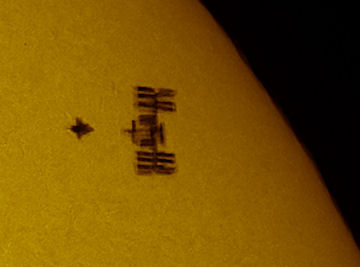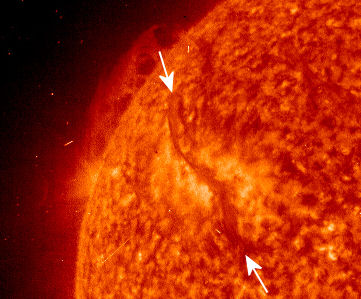NEW AND IMPROVED: Turn your iPhone or iPod Touch into a field-tested global satellite tracker. The Satellite Flybys app now works in all countries. | | | AURORA ALERT: Sky watchers should be alert for auroras tonight. Earth is entering a high speed solar wind stream, and this could cause geomagnetic storms at high latitudes. SPACESHIPS IN THE SUN: Last Sunday, May 16th, in the blue skies of Spain, a pair of tiny shadows flitted across the sun. Astrophotographer Theirry Legault and his telescope were in the countryside outside Madrid, and this is what they saw: 
"It was a solar transit of space shuttle Atlantis and the ISS," says Legault, who traveled from France to witness the event. "The time was 13:28 UT, about 50 minutes before docking. Atlantis had just begun the 'R-bar pitch maneuver'--a backflip that exposes the shuttle's heat-shield to the crew of the ISS for inspection." Because of the high orbital velocity of the ISS, its occasional transits of the sun last no more than a split-second (0.54s in this case) and require considerable skill to catch. "I stationed myself near a small town named Saelices in a quiet area with nobody around," says Legault. "I prefer to be alone because I need the concentration!" NASA's shuttle program is coming to an end later this year, and Atlantis is making her final scheduled voyage. For this reason, the STS-132 mission patch shows Atlantis heading into the sunset. There is, however, a possibility that Atlantis might fly again. If so, make that sunset a solar transit. SOLAR FILAMENT: The sun may be spotless today, but it certainly is not blank. A long dark magnetic filament is looping around the northeastern limb, stretching almost 100,000 km from end to end: 
Credit: Solar and Heliophysics Observatory (SOHO))
Long, bushy filaments like this have been known to grow unstable and erupt, producing a type of spotless flare called a "Hyder flare." If that happens now, Earth would likely feel some effects from the blast because the filament is turning to face our planet. Readers with solar telescopes are encouraged to monitor developments. more images: ; from Francisco A. Rodriguez of Cabreja Mountain Observatory, Canary Islands; from Pete Lawrence of Selsey, West Sussex, UK; from Jo Dahlmans of the Netherlands; from Ingmar Glass of München, Germany; from Stephen Yeathermon of Santa Fe, Texas; from Matt Wastell of Paddington, Brisbane, Australia
May 2010 Aurora Gallery
[previous Mays: 2008, 2005, 2004, 2003, 2002] [aurora alerts] | 
